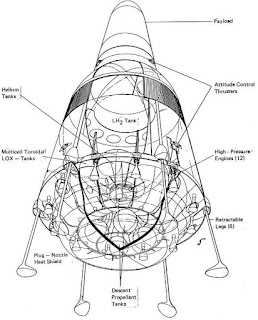I'll start with the present and work backwards in time. Blue Origin is developing the New Shepard, which is a suborbital craft. It appears to be designed for space tourism, not for space exploration. Perhaps at some point, there may be more ambitious projects for this concept, but this is all I know for now.
The New Shepard is based upon the DC-X design. It was developed in conjunction with Reagan's Strategic Defense Initiative , and subsequently transferred to NASA in the Clinton era. This craft was intended to start with suborbital flights and then orbital flights as experience and knowledge was gained. It was intended to be a SSTO project, which had its roots in some research done in the Apollo Era, looking forward to post Apollo, now known as the Shuttle Era.
The DC-X really didn't get that far in achieving its goals. But let's look at its origins, as we continue going back into time. A European variant of an integral Single Stage to Orbit design, called BETA, was itself a consequence of a design that didn't get off the drawing boards.
Excerpt:
The BETA concept is characterized by the following features:
- A short conical body (small length/diameter ratio, low c.g.) with heat-shield for re-entry
- Use of the heat-shield as a plug-nozzle for performance increase
- A propulsion system consisting of 12 or more single high-pressure LH2/ LOX engines arranged around the central plug-nozzle (heat-shield)
- 6 retractable legs for the final vertical landing phase.
 |
| Space Future.com |
- The development of a single stage ballistic space shuttle is feasible with the present technology.
- The transportation cost Earth-to-Orbit can be reduced to some 200 $/kg or less.
- The single-stage concept allows new possibilities for launch ranges since no
danger by expendable parts or stages has to be expected. This means that launches from and landings within Europe would be feasible. - The BETA Concept seems to be a solution for specific European requirements since there is no manned space flight programme, there does not exist the 500 km/550 space station target orbit, and there is no requirement for a large cross range capability.
"From the very principle the BETA Concept seems to be the final solution for the space transportation problem since it combines operational simplicity with lowest cost both for development and specific payload cost."
But it wasn't implemented.
But where did the BETA come from? It was an updated version of Douglas SASSTO, from the Apollo Era.
The SASSTO was intended to put a small capsule into orbit by using ideas from S-IVB upper stage of the Apollo Era Saturn rocket.
Alright, now note this:
Bono noticed that the S-IVB stage, then just starting to be used operationally, was very close to being able to reach orbit on its own if launched from the ground. Intrigued, Bono started looking at what missions a small S-IVB-based SSTO could accomplish, realizing that it would be able to launch a manned Gemini capsule if it was equipped with some upgrades, notably an aerospike engine that would improve the specific impulse and provide altitude compensation.[2] He called the design "SASSTO", short for "Saturn Application Single-Stage To Orbit". [comment: emphasis mine, quite impressive that this rocket existed almost half a century ago.]It appears that a renewed effort at an SSTO could achieve the results desired. The inflatable heat shield could be used in place of aerospike engines, if these are too difficult to perfect. They may even be used as a safety margin, since the mass of such a device should be small.
A second stage recovery wouldn't be necessary if there's no second stage. You will need a powerful enough rocket to get to space, plus solve the knotty problem of finding a way to get back without destroying the rocket on reentry. That's a technical problem that may be solvable.
Blue Origin may not be interested in tackling this problem, but somebody may be able to. Anybody listening?
No comments:
Post a Comment